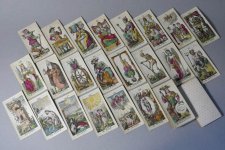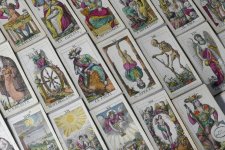These notes below are probably faulty, taken from bits and pieces of the Il Solleone newsprint foldouts and beginning to be supplemented by the Lo Scarabeo book on the Ancient Tarots of Lombardy or (Neoclassical 1810) with Giordano Berti/Marisa Chiesa...I'll add more, correct and revise based on comments. Di Gumppenberg biographical notes
From the Trade Sites of Milan from Il Solleone
Di Gumppenberg highlights - I notice Il Solleone prints the name as follows:
Ferdinando Gumppenberg
Born Jan 3, 1788 from Franco and Caterina Sala. It says born to Monaco of Baveria, Monoco being a city-state, Baveria being the country in 1788?
1805-1809--Apprenticed in the art of cards press (printers) in the important Fabbicante di Monaco
1809--Enlightenment, the Regia Fabbrica (regional maker?) of the cards transfers to Milan---I believe this is within Napoleon's reign, near the end.
Cerulean Mari's note: I also believe that one of the historical events that might have influenced the making of the Neoclassical of 1811 might have been the birth of Napoleon's son in March of 1811, known as the "King of Rome" and crowned with the Iron Crown of Lombardy.* (Di Gumppenberg did issue a later deck in celebration of Emporer Ferdinand)
1809-1814 Produces numerous original cards.
1810, 1811 "Tarocco Neoclassico Italiano," Milano - (Note Kaplan suggests 1806 or thereabouts in dating). My copy is reprinted in 1980 in an edition of 1,500.
1812 Marries Marianna Pohl
1814 Liquidation of the Regia Fabbrica di Milano.
Cerulean Mari's note: Possibly this means that the card-making is no longer controlled regionally or restricted or the designation from Napoleon's 'restriction' was lifted and now competition from other Milanese cardmakers
1814, July--Gumppenberg initiates activity near the Giardino (either the garden district?)
1816? I have to translate this note*
1820 - note related to the bottega di Caffe in Borgo di Cittadella
1820 "Il Dilettevole Giuoco del Cucco,"41 cards, stamped 1820, to 1846. Il Solleone published 1,500 copies in 1981. (Cerulean has never seen this set*).
1820-25--produces "Tarocco Vedute e Meistieri de Milano"...alternative name of Trade Sites of Milan Tarocco?
Il Solleone published 1000 copies in 1982.
1825 --Printer negotiates in Corsia del Giadino "sono in vendita anche biglietti della Lotteria"...
1835 (1830-45)--"Tarocchino Lombardo".
Il Solleone's note: engraved by Carlo Dellarocca around 1835, and then the Italian note"...dal Gumppenberg, dal Lamperti e altri in Milano e Lombardia"--note correction below on Lamperti note in 1847. Lamperti is his son-in-law.
Il Solleone published their version of the Dellarocca designs in in 1981 in a limited edition of 2,000. There is another version by Lo Scarabeo, I believe.
We know this title as the Tarocco Italiano Soprafino with engravings by Carlo della Rocca.
Given this information, the mysterious beautiful additions to the Dellarocca designs might have been innovations by Lamperti and Dellarocca?
1838-40 Produces "Tarocco Della Corona Ferrea"
Iron Crown of Lombardy Tarocco * from Edizioni del Solleone, reprinted 2,500 copies, 1979.
1847-He concedes the printmaking in general to Lattanzio Lamperti, the spouse of his daughter Paola.
Lamperti Tarocco sample:
http://www.wopc.co.uk/italy/lamperti.html
(R. Somerville had an old link to 22 card mignon Tarocco from Lo Scarabeo, but it's no longer available).
1855- Dies after 67 years.
*A quick translation. Any input appreciated, I'll correct later. I'm still gathering references, which includes the Lo Scarabeo book, and a catalog from the defunct publishing house of Solleone, edited by Vito Arienti.
Regards
Cerulean




